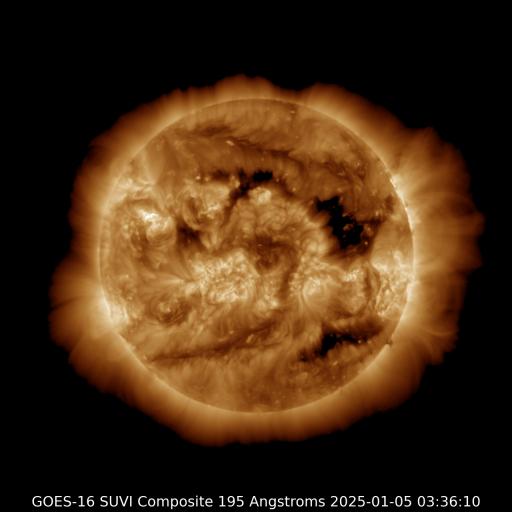Viewing archive of Thursday, 12 July 2012
Solar activity report
Any mentioned solar flare in this report has a scaling factor applied by the Space Weather Prediction Center (SWPC). Because of the SWPC scaling factor, solar flares are reported as 42% smaller than for the science quality data. The scaling factor has been removed from our archived solar flare data to reflect the true physical units.
Report of Solar-Geophysical Activity 2012 Jul 12 2200 UTCPrepared by the NOAA © SWPC and processed by SpaceWeatherLive.com
Joint USAF/NOAA Report of Solar and Geophysical Activity
SDF Number 194 Issued at 2200Z on 12 Jul 2012IA. Analysis of Solar Active Regions and Activity from 11-2100Z to 12-2100Z
Solar activity was high. At 12/1649Z, a long-duration
X1/2b flare was observed from Region 1520 (S16W09). The event was
visible in GONG H-alpha imagery as a bright ribbon flare that
erupted along the region?s long E/W oriented inversion line.
Associated with this event were Type II (1268 km/s) and Type IV
radio emissions along with an 800 sfu Tenflare. Limited satellite
imagery indicated a CME was associated with this event. STEREO
Behind COR2 imagery observed a CME lifting off the west limb, first
visible at 12/1710Z. Further analysis of this CME is ongoing.
During the past 24 hours, Region 1520 grew in both area and spot
count and maintained a complex beta-gamma-delta magnetic
configuration. Region 1521 (S21W21) also grew in area and spot
count and remained a beta-gamma magnetic classification. New
Regions 1522 (N13W21) and 1523 (S27E31) emerged on the disk as
simple bi-polar spot groups.
IB. Solar Activity Forecast
Solar activity is expected to be
moderate with a chance for X-class events for the next three days
(13 - 15 July).
IIA. Geophysical Activity Summary 11-2100Z to 12-2100Z
The geomagnetic field was at quiet to active levels with isolated
high latitude major storm intervals from 11/0600 - 1200Z. ACE solar
data indicated wind velocities decreased steadily through the period
from 500 km/s to near 400 km/s while the Bz component of the
interplanetary magnetic field did not vary much beyond +/- 5 nT.
The greater than 10 MeV proton flux at geosynchronous orbit exceeded
the 10 pfu event threshold at 12/1835Z. At the time of this report,
flux levels were at 35 pfu and rising. The greater than 100 MeV
flux at geosynchronous orbit was enhanced, but below event threshold
levels of 1 pfu. The greater than 2 MeV electron flux at
geosynchronous orbit reached high levels during the period.
IIB. Geophysical Activity Forecast
The geomagnetic field is
expected to be at mostly quiet to unsettled levels for day one (13
July). Unsettled to active levels, with isolated minor storm
intervals, are expected on days two and three (14 - 15 July) as
effects from the 12 July CME are expected to become geoeffective.
III. Event Probabilities 13 Jul to 15 Jul
| Class M | 80% | 80% | 80% |
| Class X | 35% | 35% | 35% |
| Proton | 99% | 99% | 50% |
| PCAF | red | ||
IV. Penticton 10.7 cm Flux
Observed 12 Jul 165 Predicted 13 Jul-15 Jul 165/165/165 90 Day Mean 12 Jul 127
V. Geomagnetic A Indices
Observed Afr/Ap 11 Jul 010/012 Estimated Afr/Ap 12 Jul 009/011 Predicted Afr/Ap 13 Jul-15 Jul 006/008-015/018-013/015
VI. Geomagnetic Activity Probabilities 13 Jul to 15 Jul
| A. Middle Latitudes | |||
|---|---|---|---|
| Active | 20% | 40% | 35% |
| Minor storm | 05% | 15% | 10% |
| Major-severe storm | 01% | 01% | 01% |
| B. High Latitudes | |||
|---|---|---|---|
| Active | 20% | 10% | 15% |
| Minor storm | 25% | 30% | 30% |
| Major-severe storm | 25% | 55% | 45% |
All times in UTC
Current data suggests there is a slight possibility for aurora to appear at the following high latitude regions in the near future
Gillam, MB, Iqaluit, NUNuuk
Reykjavik
Latest news
Latest forum messages
AR4048 123Aurora photography hints for those of us with smartphones 66AR 4054 20New satellites - Proba-3, PUNCH, SWFO-L1, GOES-U/19 46Incoming & Unnumbered Active Regions 1672
More topicsSupport SpaceWeatherLive.com!
A lot of people come to SpaceWeatherLive to follow the Sun's activity or if there is aurora to be seen, but with more traffic comes higher server costs. Consider a donation if you enjoy SpaceWeatherLive so we can keep the website online!

Latest alerts
00:55 UTC - Coronal hole
A southern hemisphere coronal hole is facing Earth. Enhanced solar wind could arrive in ~3 days
Monday, 7 April 2025
20:45 UTC - Geomagnetic activity
Active geomagnetic conditions (Kp4) Threshold Reached: 20:39 UTC
17:33 UTC - Hemispheric Power Index
The OVATION model predicts the Hemispheric Power Index to reach 51GW at 18:18 UTC
Space weather facts
| Last X-flare | 2025/03/28 | X1.1 |
| Last M-flare | 2025/04/05 | M1.0 |
| Last geomagnetic storm | 2025/04/06 | Kp5 (G1) |
| Spotless days | |
|---|---|
| Last spotless day | 2022/06/08 |
| Monthly mean Sunspot Number | |
|---|---|
| March 2025 | 134.2 -20.4 |
| April 2025 | 148.7 +14.5 |
| Last 30 days | 134.1 -5.6 |




